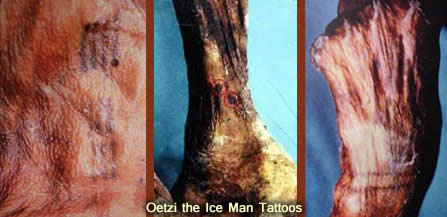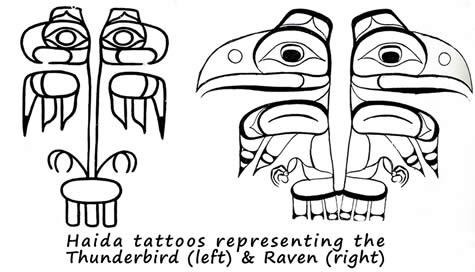
|
|
| Celeb Tattoos | Facts & Stats | Designs & Symbols | History | Culture | Links | Tattoo Galleries | Contact | |
|
What Makes a Good Tattoo? Article © 2009 PJ Reece
Who thought that selecting a 'good' tattoo would be such an intellectual exercise? Symbols, though, seem pretty safe, either well-established icons or those that arise from our own dreams or meditations. The classical Greek philosopher, Plato, believed that earthly life was only a shadow of a transcendent realm of absolutes (perhaps in some parallel universe). He believed that we achieved our human potential when recollection of that perfect world was awakened in us - by symbols, for example. Symbols are especially good at that. Recovering what needs to be discovered in our lives at a particular time gives our lives direction. If contemplation of a tattooed symbol can do that, then perhaps what we have is 'tattoo as guiding light'. (Are you taking notes, yet?) In his booklet, Art & Healing: A Practical Guide, Ramon Kubicek points out how commonplace are media reports of the destructive power of pornography, obscenity, racism, sexism and violence - yet "seldom do we acknowledge the converse possibility - the transformative power of words and visual images." Although Kubicek wasn't thinking of tattoos while writing his thesis, it's no leap at all to apply his ideas to the prospect of tattoo as healing art. He explains how our sense of sight affects every major system in the body, concluding that what we see has a direct and dynamic effect on us. "So profound is this influence," writes Kubicek, "that everything from major psychological shifts, to our everyday living, to our very survival depends on what the eyes bring." Tattoo as agent for emotional healing - it's being deployed by more and more women in the aftermath of a mastectomy. Reconstructive surgery remains the therapeutic norm, but covering the scar with a tattoo has proven a viable alternative. "Transformation through tattooing over a scar can have a powerful effect," says Madame Chinchilla, author of Stewed, Screwed and Tattooed (2005). In a chapter titled, "In Celebration of a Scar" one of Chinchilla's clients testifies, "With this tattoo, I stepped through another doorway in my life... a ceremony of transformation...a circle of healing." "Tattooing these beautiful, spirited women was different from tattooing other women," says Madame Chinchilla, "because we were creating a space where beauty could arise from a place of sheer terror and pain." Better than building a fake breast is to rebuild one's physical self-acceptance, even one's sexual self-image. Where a tattoo has that effect, it's hard to imagine a more definitive example of tattoo as 'applied art'. Health tattoos - Tibetans have been putting them to work in order to achieve balance both inner and outer. Sacred images are prescribed - mantras, mantra wheels and flags. They've also been applying tattoos to acupuncture points, mixing medicinal herbs into the dyes in the belief they provide a lasting cure. Tattoo as cure - it's got a history going back over 5000 years, and we've got the mummy to prove it. 'Otzi' the Iceman, the well-preserved corpse discovered in an Austrian glacier in 1991, had 57 tattoos including series of lines on his spine and joints that experts insist are acupressure points. Tattoo as applied physician. Whatever decorative functions his tattoos might have served, it's clear that some of them were expected to perform 24/7.
In the early 1990s, Romanian artist Dan Perjovschi took on a tattoo as a device to heal his nation in the aftermath of communism's collapse. In a public event, he had the word 'Romania' inked high on his left arm. Perjovschi's colleagues must have been suspicious, since Perjovschi the artist was more inclined to bamboozle people than to heal them. His tattoo must have had designs beyond simply assuaging Romania's collective pain. At first glance, the tattoo was a nationalistic statement that appeared to peg him as member of the highly conformist Romanian society, except that Perjovschi was well known as a critic of the status quo. As he was being 'branded like a cow', people may have wondered what this famous artist was really trying to say with his body art. Perhaps he was objectifying himself, an allusion to Romanians and their history of being dehumanized. Or was he aligning himself with the tattooed underclass -- prisoners, gypsies and sailors? Who knew, for sure? Here was tattoo as performance art, as national conversation piece - and Perjovschi wasn't finished yet. He produced a series of photographs of himself - tattoo clearly visible - in front of shabby Bucharest venues, including a primitive outhouse in a field which he titled, "The Most Beautiful Country in the World". Ten years later, Perjovschi put his tattoo to work again, this time in an equally public display of having it removed. Whereas his previous stunt was dripping with irony - his tattoo said one thing and meant the opposite - this time it was a straightforward rejection of human branding. By removing 'Romania' - had he decided that his identity no longer depended on his nationality? The metaphor of Perjovschi's tattoo, even after it had been removed, continued. Ten laser treatments later, 'Romania' was unreadable, yet the process left traces of dissolved pigment under the skin - what was he trying to say now? That his country still remains within him? Perjovschi's tattoo performed for him even after it was gone! How good is that? Tattoo as grist for the mill of an entire nation contemplating its identity. We know from studies of living indigenous cultures that the tattoo has long functioned as a mark of identity. Natives of the Pacific Northwest used animal emblems as crests (totems) to identify the different social divisions within their society. These bold and famously recognizable designs 'explained the existence of their world,' says anthropologist, Lars Krutak, in his article "Crest Tattoos of the Tlingit and Haida of the Northwest Coast". Decorating their architecture as well as their bodies, the images linked them with the natural environment. Krutak writes:
Decoration, maybe, but first and foremost a hard-working tattoo. A world away, in the jungles of Borneo, the Dayak people heaped even
more responsibility on their tattoos, dependent as they were upon them
to protect against evil forces. The hornbill (bird) tattoo, for
instance, signifying rank and prestige, was also believed to be a weapon
against evil spirits. Among the Iban, a frog tattooed on the neck was
protection against losing one's head, literally. Frogs are believed to
be the earthly manifestation of their creator god, and to the Kayan
tribes it was these creatures who revealed the secrets of headhunting to
the warrior society. Look at a tadpole's belly and you'll see clearly
through its translucent skin to its spiraling intestines - then, look at
the shoulders of any elderly Dayak man today and see that same timeless
spiral motif as tattoo. [see all this in the documentary
The Vanishing Tattoo]
Tattoo as ontological security blanket - an Iban would not have left home without it. More importantly, he would never have embarked on the ultimate journey to the afterlife, since an Iban believed that his tattoos lit the way for the soul as it navigated a path through the 'land of the dead' in search of the longhouse inhabited by his ancestors. Tattoo as talisman, worn to avert danger, even death, and performing its most crucial role after death - we can't overstate the importance of the tattoo to animistic cultures, nor to indigenous peoples today who haven't entirely abdicated their role within ecological and psychic systems of unknowable complexity. Tattoo as insurance policy for your soul - that's got to be a good tattoo. Yet, isn't that what society is still about - the attempt to establish order amidst chaos. ('It's a jungle out there.') Tattooing, like education, attitudes and opinions, likes and dislikes, even clothing and jewelry, is an opportunity to arrange our existential disorder. But Donald Richie has a warning for us as we seek out the best tattoo:
Richie differentiates between societies where personality is achieved by cultivating our inner life, intellect, etc, and countries like Japan that traditionally have placed importance on the outer, the façade. Western cultures create a black and white world of rights and wrongs, setting life in concrete for the sake of consistency, sanity, and security. A Japanese traditionally arranged his surface "in a manner he considers set, fixed, indubitable. Hence all the costume wearing, hence all the wearing of badges and other identifying emblems, and hence also, and in this sense, tattoos." [The Japanese Tattoo, pg. 65] Inner-oriented Westerner that I am, my motivations for taking on an ancient tattoo motif are therefore going to be examined carefully. Skin ink is suddenly fashionable - is that why I'm considering it? If I should convince myself of a tattoo's efficacy, will it remain at best a sad reflection of the powerful icons that served the animistic societies that gave birth to the tattoo? Should it matter? And why do I care? |
|
|
|
|
| Celeb Tattoos | Facts & Stats | Designs & Symbols | History | Culture | Links | Tattoo Galleries | Contact | |
 Consider Krystyne Kolorful, one
of the most heavily tattooed woman on the planet - she discovered that
tattoos made her stronger 'because of the incredible flack I had to face
in the outside world.' In defence of her chosen art form, she claims she
was forced to assert herself. Feminist critics, however, question the
tattoo as a means of empowerment for women, arguing that:
Consider Krystyne Kolorful, one
of the most heavily tattooed woman on the planet - she discovered that
tattoos made her stronger 'because of the incredible flack I had to face
in the outside world.' In defence of her chosen art form, she claims she
was forced to assert herself. Feminist critics, however, question the
tattoo as a means of empowerment for women, arguing that:
